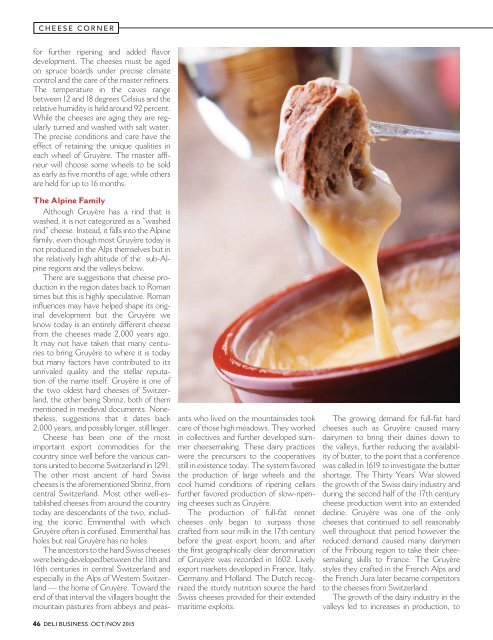DELI BUSINESS
1iADwm7
1iADwm7
Create successful ePaper yourself
Turn your PDF publications into a flip-book with our unique Google optimized e-Paper software.
CHEESE CORNER<br />
for further ripening and added flavor<br />
development. The cheeses must be aged<br />
on spruce boards under precise climate<br />
control and the care of the master refiners.<br />
The temperature in the caves range<br />
between 12 and 18 degrees Celsius and the<br />
relative humidity is held around 92 percent.<br />
While the cheeses are aging they are regularly<br />
turned and washed with salt water.<br />
The precise conditions and care have the<br />
effect of retaining the unique qualities in<br />
each wheel of Gruyère. The master affineur<br />
will choose some wheels to be sold<br />
as early as five months of age, while others<br />
are held for up to 16 months.<br />
The Alpine Family<br />
Although Gruyère has a rind that is<br />
washed, it is not categorized as a “washed<br />
rind” cheese. Instead, it falls into the Alpine<br />
family, even though most Gruyère today is<br />
not produced in the Alps themselves but in<br />
the relatively high altitude of the sub-Alpine<br />
regions and the valleys below.<br />
There are suggestions that cheese production<br />
in the region dates back to Roman<br />
times but this is highly speculative. Roman<br />
influences may have helped shape its original<br />
development but the Gruyère we<br />
know today is an entirely different cheese<br />
from the cheeses made 2,000 years ago.<br />
It may not have taken that many centuries<br />
to bring Gruyère to where it is today<br />
but many factors have contributed to its<br />
unrivaled quality and the stellar reputation<br />
of the name itself. Gruyère is one of<br />
the two oldest hard cheeses of Switzerland,<br />
the other being Sbrinz, both of them<br />
mentioned in medieval documents. Nonetheless,<br />
suggestions that it dates back<br />
2,000 years, and possibly longer, still linger.<br />
Cheese has been one of the most<br />
important export commodities for the<br />
country since well before the various cantons<br />
united to become Switzerland in 1291.<br />
The other most ancient of hard Swiss<br />
cheeses is the aforementioned Sbrinz, from<br />
central Switzerland. Most other well-established<br />
cheeses from around the country<br />
today are descendants of the two, including<br />
the iconic Emmenthal with which<br />
Gruyère often is confused. Emmenthal has<br />
holes but real Gruyère has no holes.<br />
The ancestors to the hard Swiss cheeses<br />
were being developed between the 11th and<br />
16th centuries in central Switzerland and<br />
especially in the Alps of Western Switzerland<br />
— the home of Gruyère. Toward the<br />
end of that interval the villagers bought the<br />
mountain pastures from abbeys and peasants<br />
who lived on the mountainsides took<br />
care of those high meadows. They worked<br />
in collectives and further developed summer<br />
cheesemaking. These dairy practices<br />
were the precursors to the cooperatives<br />
still in existence today. The system favored<br />
the production of large wheels and the<br />
cool humid conditions of ripening cellars<br />
further favored production of slow-ripening<br />
cheeses such as Gruyère.<br />
The production of full-fat rennet<br />
cheeses only began to surpass those<br />
crafted from sour milk in the 17th century<br />
before the great export boom, and after<br />
the first geographically clear denomination<br />
of Gruyère was recorded in 1602. Lively<br />
export markets developed in France, Italy,<br />
Germany and Holland. The Dutch recognized<br />
the sturdy nutrition source the hard<br />
Swiss cheeses provided for their extended<br />
maritime exploits.<br />
The growing demand for full-fat hard<br />
cheeses such as Gruyère caused many<br />
dairymen to bring their dairies down to<br />
the valleys, further reducing the availability<br />
of butter, to the point that a conference<br />
was called in 1619 to investigate the butter<br />
shortage. The Thirty Years’ War slowed<br />
the growth of the Swiss dairy industry and<br />
during the second half of the 17th century<br />
cheese production went into an extended<br />
decline. Gruyère was one of the only<br />
cheeses that continued to sell reasonably<br />
well throughout that period however the<br />
reduced demand caused many dairymen<br />
of the Fribourg region to take their cheesemaking<br />
skills to France. The Gruyère<br />
styles they crafted in the French Alps and<br />
the French Jura later became competitors<br />
to the cheeses from Switzerland.<br />
The growth of the dairy industry in the<br />
valleys led to increases in production, to<br />
46 <strong>DELI</strong> <strong>BUSINESS</strong> OCT/NOV 2015


